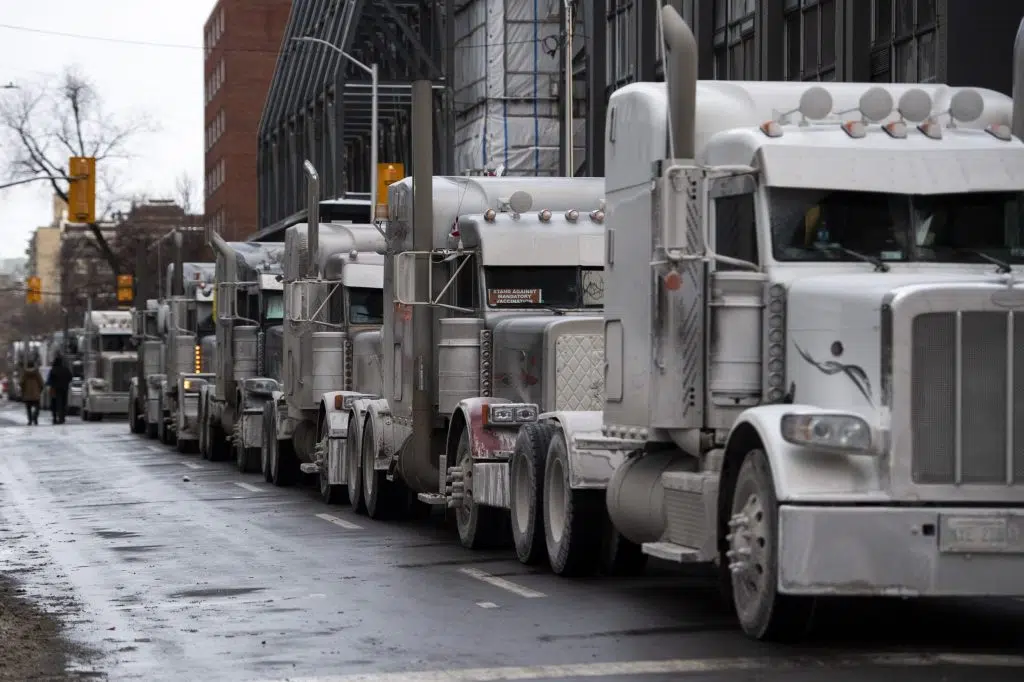A former Saskatoon resident who now works at the Children’s Hospital of Eastern Ontario (CHEO) says the past week has been “horrific” for many living and working in Ottawa.
David Scharf says since the trucker convoy descended on downtown Ottawa, it has had a huge, negative impact not only on the 50,000 or so residents who live in the area, but also for people who need to drive through that part of the city to get to their jobs.
That includes staff at the hospital.
“We’ve had children who have been unable to get to our hospital for care,” Scharf said. “We’ve had staff who have had to sleep at the hospital because they are unable to get in and out of their homes in the downtown core.
“We’ve had members of our staff assaulted on the Light Rail Transit — assaulted for wearing a mask. A number of events like that that are affecting our ability to care for kids, that has been a huge concern to us.”
During the first weekend the protest took place, Scharf described some staff having to detour up to 25 kilometres to get to work.
“Almost all of the bridges from Ottawa across the river — to Gatineau in Quebec — are also all centred around that downtown core,” he said. “So there was huge disruption for the people trying to get to and from CHEO from the Quebec side. We serve children and families from Gatineau.”
Police had one lane open on that bridge only for health-care workers who could show ID and were needed to be escorted to get to work. Now the bridges are open and there is less disruption.
Scharf lives a few kilometres from the epicentre of the protest, but went to the area on Sunday. His son lives there.
“I purposefully did not wear my mask when I went through because by all accounts if you do, you certainly will be harassed,” he said.
Scharf did say while he walked through, he saw protest signs from a variety of different groups but he didn’t see any swastikas or anti-Semitic messaging. However, he did notice that some local businesses like the Rideau Centre mall have been closed.
“I think the only appropriate description is an occupation,” he added. “The reality is the occupation is limited to the downtown core … (which) you can’t easily access right now.”
Scharf is hoping something is done to end the protest soon.
“I’m very terrified of where this could go,” he said. “It’s really going to depend on a lot of things … I’m worried about how this ends. At some point you have to put an end to this illegal occupation. How you do that? Hopefully you can come to some sort of peaceful resolution and they will leave.”
Protester gives his side
One Saskatchewan protest organizer paints a far different picture of what happened, especially last weekend.
On Sunday, Ottawa’s mayor declared a state of emergency. Trucker Chris Barber said one of the reasons was to try and cut off their fuel supply.
Barber has also been named in a class-action lawsuit.
“We’ve got lawyers working on that. We’ve got a lot stuff going on; we’ve got a lot of support,” he told Gormley. “The hugs, the handshakes, the tears, the stories — we had I don’t know how many people down on Parliament Hill. It was just … bigger than Canada Day celebrations is what I was told.
“Every officer standing on the street corners couldn’t have been happier with the amount of peace and love that was going on here. We’ve been cleaning streets. We’ve been feeding the homeless (and) protecting the monuments.”
Barber said they were simply a group of fun-loving Canadians who want answers from the federal government.
Scharf said he understands that many of those involved in the protest are upset and frustrated by public health mandates, but there’s a reason for them.
“I can tell you this: There’s nobody who wants an end to this pandemic more than those of us who work in health care,” Scharf said.
“Get in your truck and go home,” he added. “Let us do our jobs.”











